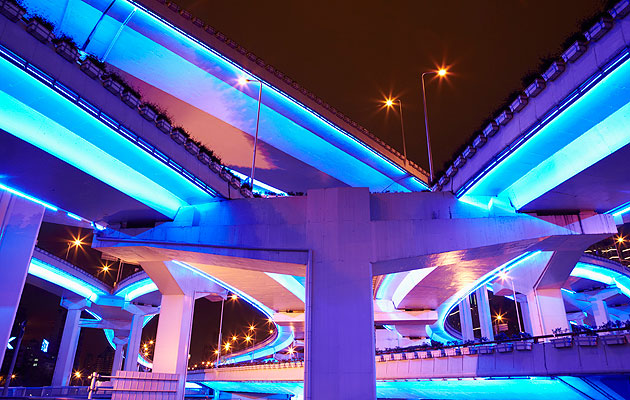|
|
||
|
Shanghai is laced with elevated roads, all built over the last ten years or so, at roughly the same time, but to rather more impressive effect, as the Metro system. The Metro is very nice, but aesthetically forgettable; this system of flyovers is monstrous, dominant and utterly unforgettable. At Huaihai Park there’s a sort of flyover convention, an intersection which is less spaghetti junction and more the intestines of a terrifying mythological beast. This kind of organic metaphor tends to come to mind here, because there’s little rationalistic or machinic about the scenery. The concrete itself is of the very highest grade, but there is also planting running half the way up the concrete pillars, an effort at civic beautification which is visible mainly to the pedestrian, more than to the driver. Presumably this is there as a gesture to what the Chinese Communist Party calls “The Harmonious Society”, with nature intersecting with technology in non-antagonistic manner – but it’s far more like the engineers kept in mind the possibility that sooner rather than later these monuments will be obsolete, so made them pre-ruined, with picturesque vegetation creeping up them to simulate what they might look like when they’ve fallen into desuetude.
Groping around for comparisons, the nearest thing seems to be the spidery expressways of Los Angeles – but those course through a low-density suburban sprawl, rather than charging through super-dense conglomerations of competing skyscrapers. But here too, the flyovers are the main event, works of public infrastructure more impressive than the baubles on top of the towers of capital. Their forcing through areas of already huge density necessitates an extra pedestrian layer being inserted into them – plenty of these intersections have pedestrian walkways running across, with blue steel and glass pedways sandwiched between the roads. It’s hard not to wonder: how does this work, how does this sustain itself, and how do you get to the point where you’re entirely blasé about it all? Looking up at the flyovers, I’m as completely at a loss to get any impression of how all this works as I would be looking at an electrical diagram. I’m only capable of interpreting it as an abstract sculpture or as a shocking biomorphic organism – a potentially lethal one, in both cases – but not as a road. You’d have to live here for a while for that prosaic familiarity to come. Keep contemporary China’s massive inequalities out of your head for a moment, and the “Shanghai as the Future” argument is the most seductive potential tomorrow on offer in the dubious field of architectural futurology. To the untrained eye – very untrained – this seems the more preferable future city, more than the hooray-for-shanty-towns version or the isn’t-Dubai-like-super-interesting strain. The Foxconn factory in Shenzhen, where workers make gadgets for the West in abominable conditions, is a long way from the centre of Shanghai, and the ugliness of primitive accumulation is less immediately apparent; and I didn’t see anyone sleeping under these flyovers. But the real reason why Shanghai-as-the-future is so convincing is because it looks like you imagined the future would look like when you were 14 years old. If the primary coloured wipe-clean architecture of New Labour Britain was designed by and for overgrown infants, Shanghai seems to have been designed by and for overgrown adolescent boys. Shanghai’s sheer revelling in its own modernity is very difficult to resist, at first, and it’s most difficult to remain critical when you travel along the flyovers at night. You can only stare in abandonment at a city which lines its flyovers in endless strips of blue neon at night, that makes the mundane act of driving into an abstract procession of light and geometry, that intensifies the process of commuting into this outrageous onrush of non-objective sensation. There are apparently a lot of car crashes in Shanghai. “What’s this for?” I ask a friend, somewhat taken aback by the neon. “Aesthetics!” he answers. This massive project of state-built infrastructure is the less trumpeted of the major public works in the city. There’s the Metro, of course, with nine underground lines built in the time it takes to string a tram line from one side of Manchester to the other, but there’s also the Maglev magnetic levitation train, which gets you – at record-breaking speed! – merely from the airport to the tabula rasa business district in Pudong; and an outward extension was recently cancelled. The Maglev might be the one area where the People’s Republic tried doing something differently, where it put a genuinely advanced technology at the service of a public, rather than private means of transport, but compared with these monuments to the hope that 1.8 million people get a private car each, it seems paltry indeed. |
Image Michael Haegele
Words Owen Hatherley |
|
|
||
|
|
||

















